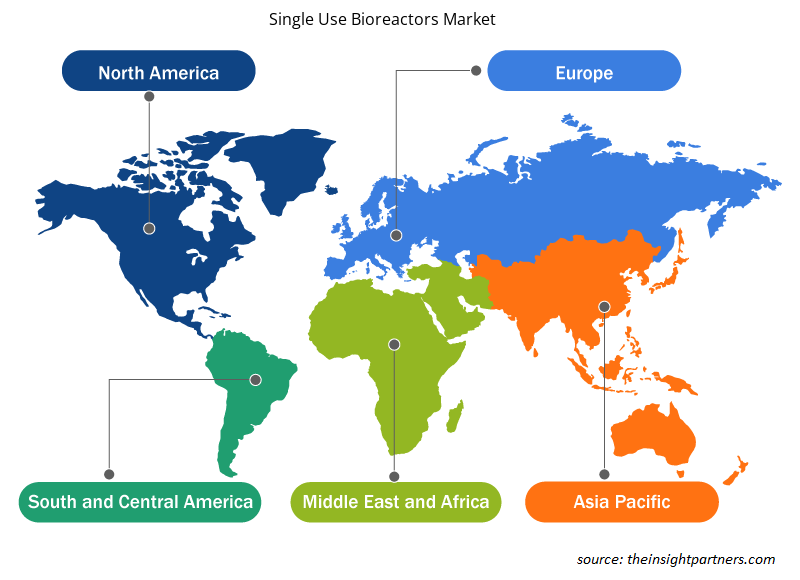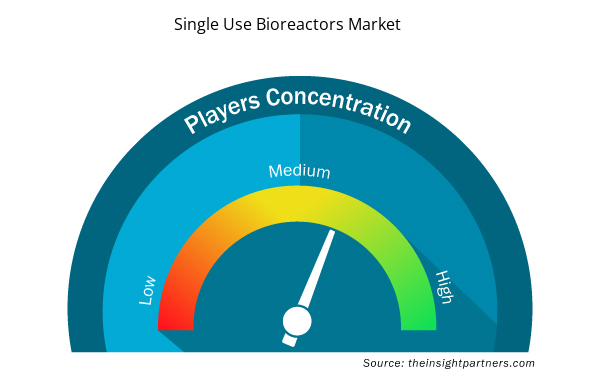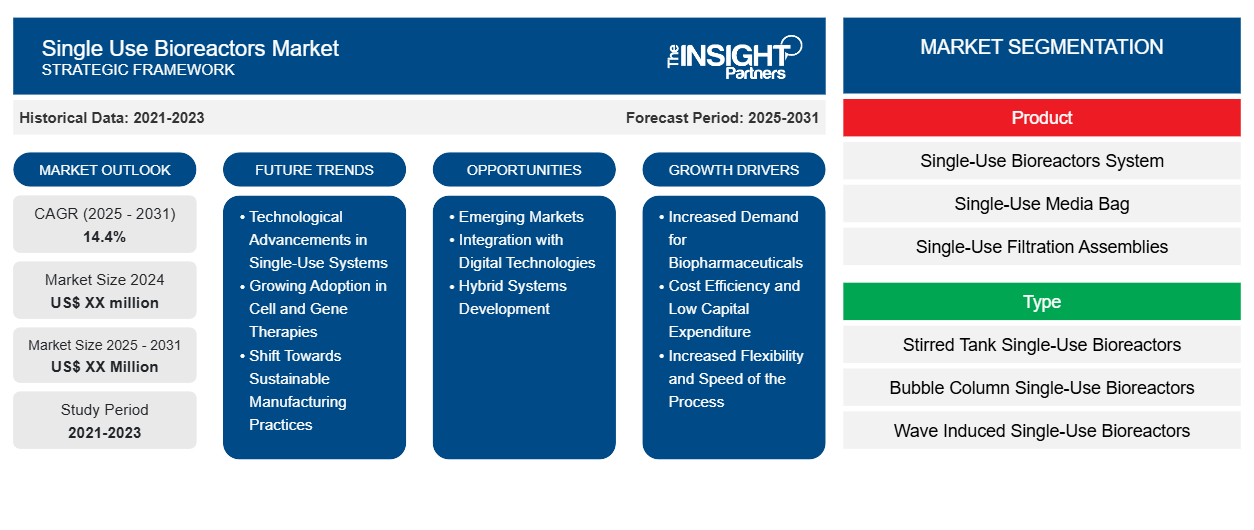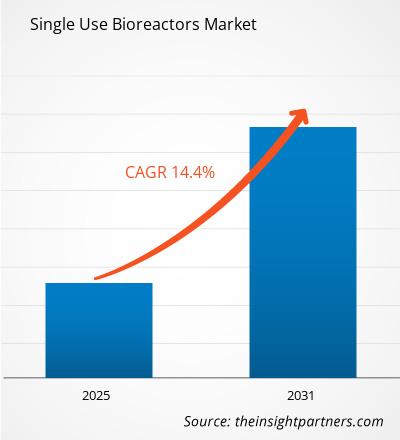Se espera que el mercado de biorreactores de un solo uso registre una CAGR del 14,4 % entre 2024 y 2031, con un tamaño de mercado que se expandirá de US$ XX millones en 2024 a US$ XX millones en 2031.
El informe presenta un análisis basado en Producto (Sistema de biorreactores de un solo uso, Bolsa de medios de un solo uso, Conjuntos de filtración de un solo uso, Otros); Tipo (Biorreactores de un solo uso de tanque agitado, Biorreactores de un solo uso de columna de burbujas, Biorreactores de un solo uso inducidos por ondas); Tipo de molécula (Anticuerpos monoclonales, Vacuna, Células madre, Células modificadas genéticamente, Otras moléculas); Tipo de célula (Células de mamíferos, Células bacterianas, Células de levadura, Otras células); Aplicación (Investigación y desarrollo, Desarrollo de procesos, Bioproducción, Otros); Usuario final (Compañías farmacéuticas y biofarmacéuticas, Institutos académicos y de investigación, Organizaciones de investigación por contrato (CRO) y Organizaciones de fabricación por contrato (CMO)). El análisis global se desglosa aún más a nivel regional y por países principales. El tamaño del mercado y el pronóstico a nivel global, regional y de país para todos los segmentos clave del mercado están cubiertos bajo el alcance. El informe ofrece el valor en USD del análisis y los segmentos anteriores. El informe proporciona estadísticas clave sobre el estado del mercado de los actores clave y ofrece tendencias y oportunidades del mercado.
Propósito del Informe
El informe Single Use Bioreactors Market de The Insight Partners tiene como objetivo describir el panorama actual y el crecimiento futuro, los principales factores impulsores, los desafíos y las oportunidades. Esto proporcionará información a diversas partes interesadas del negocio, como:
- Proveedores/fabricantes de tecnología: Para comprender la dinámica cambiante del mercado y conocer las oportunidades potenciales de crecimiento, lo que les permitirá tomar decisiones estratégicas informadas.
- Inversionistas: Realizar un análisis exhaustivo de tendencias sobre la tasa de crecimiento del mercado, las proyecciones financieras del mercado y las oportunidades que existen en toda la cadena de valor.
- Órganos reguladores: Regular las políticas y vigilar las actividades del mercado con el objetivo de minimizar los abusos, preservar la confianza de los inversores y defender la integridad y estabilidad del mercado.
Segmentación del mercado de biorreactores de un solo uso
Producto
- Sistema de biorreactores de un solo uso
- Bolsa de un solo uso para medios de comunicación
- Conjuntos de filtración de un solo uso
- Otro
Tipo
- Biorreactores de un solo uso con tanque agitado
- Biorreactores de columna de burbujas de un solo uso
- Biorreactores de un solo uso inducidos por olas
Tipo de molécula
- Anticuerpos monoclonales
- Vacuna
- Células madre
- Células modificadas genéticamente
- Otras moléculas
Tipo de célula
- Células de mamíferos
- Células bacterianas
- Células de levadura
- Otras células
Solicitud
- Investigación y desarrollo
- Desarrollo de procesos
- Bioproducción
- Otro
Personalice este informe según sus necesidades
Obtendrá personalización en cualquier informe, sin cargo, incluidas partes de este informe o análisis a nivel de país, paquete de datos de Excel, así como también grandes ofertas y descuentos para empresas emergentes y universidades.
- Obtenga las principales tendencias clave del mercado de este informe.Esta muestra GRATUITA incluirá análisis de datos, desde tendencias del mercado hasta estimaciones y pronósticos.
Factores impulsores del crecimiento del mercado de biorreactores de un solo uso
- Mayor demanda de productos biofarmacéuticos: otro factor que impulsa el desarrollo del mercado de biorreactores de un solo uso es la creciente necesidad de productos biofarmacéuticos, incluidos anticuerpos y vacunas. A medida que la demanda de productos biofarmacéuticos sigue creciendo dentro de la industria, las empresas exigen sistemas de producción flexibles y eficientes que respondan a una variedad de escalas y tipos de productos. Los biorreactores de un solo uso reducen los riesgos de contaminación y la demanda de limpieza, lo que proporciona ciclos de producción más rápidos y permite respuestas más rápidas a las demandas de los mercados.
- Rentabilidad y bajo gasto de capital: Los biorreactores de un solo uso ofrecen ventajas en términos de costos, especialmente para las empresas medianas y pequeñas. Estos sistemas evitan los procesos de limpieza y esterilización que consumen mucho tiempo y, por lo tanto, reducen los costos operativos y ahorran mucho tiempo. Además, sus características de escalabilidad permiten al fabricante reducir la inversión de capital en infraestructura para penetrar fácilmente en el mercado y responder a las fluctuaciones de la producción.
- Mayor flexibilidad y velocidad del proceso: la versatilidad de los biorreactores de un solo uso contribuye al crecimiento de este mercado. Los biorreactores de un solo uso pueden cambiar rápidamente un proceso de producción para adaptarse rápidamente a diferentes productos o escalas de producción. Esta flexibilidad respalda la tendencia hacia la medicina personalizada y los lotes más pequeños, ya que las empresas pueden cambiar de un producto a otro con facilidad. Esto significa que los biorreactores de un solo uso son cada vez más preferidos, ya que sus flujos de trabajo se pueden optimizar para ofrecer un tiempo de comercialización más rápido.
Tendencias futuras del mercado de biorreactores de un solo uso
- Avances tecnológicos en sistemas de un solo uso: Los cambios tecnológicos actuales han influido en gran medida en el mercado de los biorreactores de un solo uso en esta industria. Las tecnologías de sensores avanzadas equipadas con sistemas de monitorización integrados garantizan una mejor recopilación de datos en tiempo real y un mejor control del proceso, optimizando así los bioprocesos para lograr altos rendimientos con la calidad del producto asegurada. Por motivos de eficiencia y fiabilidad, los fabricantes las están implementando con bastante frecuencia.
- Creciente adopción de terapias celulares y genéticas: la creciente adopción de terapias celulares y genéticas está impulsando la demanda de biorreactores de un solo uso. Por lo general, estas terapias se utilizan en procesos de fabricación flexibles que pueden adaptarse en escala y tipo de producción. Los biorreactores de un solo uso son los preferidos para estos fines, ya que reducen la contaminación cruzada y permiten una producción más rápida de los productos. Esta tendencia solo se intensificará a medida que la industria biofarmacéutica se centre en las necesidades de medicina personalizada y tratamientos específicos.
- Cambio hacia prácticas de fabricación sostenibles: los biorreactores de un solo uso están pasando lentamente a tendencias de fabricación ecológica. A medida que el factor de sostenibilidad gana importancia, existe una mayor demanda de soluciones ecológicas para reducir los niveles de residuos y energía. La tecnología de un solo uso reduce el consumo de agua y energía debido al número mínimo de procesos de limpieza y esterilización involucrados. En tiempos en que los sectores industriales aceptan el uso de soluciones ecológicas, los biorreactores de un solo uso están bien preparados y orientados a la biofabricación ecológica.
Oportunidades de mercado para biorreactores de un solo uso
- Mercados emergentes: Los biorreactores de un solo uso prometen ofrecer enormes oportunidades en los mercados emergentes, ya que la industria biofarmacéutica se está construyendo rápidamente en esas regiones. El aumento de las inversiones en biotecnología e infraestructura sanitaria aumenta la demanda de soluciones de fabricación eficaces y flexibles. También se lograría el crecimiento de los mercados, así como una presencia más amplia, si se centrara la atención en esas áreas.
- Integración con tecnologías digitales: Inevitablemente, el mercado de biorreactores de un solo uso se enfrentará a una explosión de oportunidades de integración digital. Entre ellas, se incluyen la inteligencia artificial y el aprendizaje automático como nuevas tecnologías para optimizar el procesamiento de datos, la optimización de procesos y el mantenimiento predictivo. Con su crecimiento hacia un modelo impulsado por los datos, las empresas utilizarán esta tecnología para superar a sus competidores en la optimización de los procesos de producción y, al mismo tiempo, reducir los costos.
- Desarrollo de sistemas híbridos: Los sistemas de biorreactores híbridos que integran tecnologías de un solo uso y tradicionales representan una oportunidad prometedora para el mercado. Los sistemas pueden combinar la flexibilidad de los componentes de un solo uso con los beneficios de los sistemas reutilizables, satisfaciendo diferentes necesidades de producción. Este es el enfoque híbrido a través del cual los fabricantes pueden optimizar sus procesos y adaptarse a los requisitos de diversos productos y a las crecientes demandas del sector biofarmacéutico.
Perspectivas regionales del mercado de biorreactores de un solo uso
Los analistas de Insight Partners explicaron en detalle las tendencias y los factores regionales que influyen en el mercado de biorreactores de un solo uso durante el período de pronóstico. Esta sección también analiza los segmentos y la geografía del mercado de biorreactores de un solo uso en América del Norte, Europa, Asia Pacífico, Oriente Medio y África, y América del Sur y Central.

- Obtenga datos regionales específicos para el mercado de biorreactores de un solo uso
Alcance del informe de mercado de biorreactores de un solo uso
| Atributo del informe | Detalles |
|---|---|
| Tamaño del mercado en 2024 | XX millones de dólares estadounidenses |
| Tamaño del mercado en 2031 | US$ XX millones |
| Tasa de crecimiento anual compuesta (CAGR) global (2025-2031) | 14,4% |
| Datos históricos | 2021-2023 |
| Período de pronóstico | 2025-2031 |
| Segmentos cubiertos | Por producto
|
| Regiones y países cubiertos | América del norte
|
| Líderes del mercado y perfiles de empresas clave |
|
Densidad de actores del mercado de biorreactores de un solo uso: comprensión de su impacto en la dinámica empresarial
El mercado de biorreactores de un solo uso está creciendo rápidamente, impulsado por la creciente demanda de los usuarios finales debido a factores como la evolución de las preferencias de los consumidores, los avances tecnológicos y una mayor conciencia de los beneficios del producto. A medida que aumenta la demanda, las empresas amplían sus ofertas, innovan para satisfacer las necesidades de los consumidores y aprovechan las tendencias emergentes, lo que impulsa aún más el crecimiento del mercado.
La densidad de actores del mercado se refiere a la distribución de las empresas o firmas que operan dentro de un mercado o industria en particular. Indica cuántos competidores (actores del mercado) están presentes en un espacio de mercado determinado en relación con su tamaño o valor total de mercado.
Las principales empresas que operan en el mercado de biorreactores de un solo uso son:
- Merck KGaA
- Termo Fisher Scientific
- Sartorius AG
- Cesco Bioingeniería Co., LTD
- Atención sanitaria de GE
Descargo de responsabilidad : Las empresas enumeradas anteriormente no están clasificadas en ningún orden particular.

- Obtenga una descripción general de los principales actores clave del mercado de biorreactores de un solo uso
Puntos de venta clave
- Cobertura integral: el informe cubre de manera integral el análisis de productos, servicios, tipos y usuarios finales del mercado de biorreactores de un solo uso, proporcionando un panorama holístico.
- Análisis de expertos: el informe se compila sobre la base de un profundo conocimiento de expertos y analistas de la industria.
- Información actualizada: El informe asegura relevancia comercial debido a su cobertura de información reciente y tendencias de datos.
- Opciones de personalización: este informe se puede personalizar para satisfacer los requisitos específicos del cliente y adaptarse adecuadamente a las estrategias comerciales.
Por lo tanto, el informe de investigación sobre el mercado de biorreactores de un solo uso puede ayudar a abrir camino para descifrar y comprender el escenario de la industria y las perspectivas de crecimiento. Si bien puede haber algunas preocupaciones válidas, los beneficios generales de este informe tienden a superar las desventajas.
- Análisis histórico (2 años), año base, pronóstico (7 años) con CAGR
- Análisis PEST y FODA
- Tamaño del mercado Valor/volumen: global, regional, nacional
- Industria y panorama competitivo
- Conjunto de datos de Excel


- Machine Condition Monitoring Market
- Europe Tortilla Market
- Parking Management Market
- GMP Cytokines Market
- Mail Order Pharmacy Market
- Cut Flowers Market
- Artificial Intelligence in Defense Market
- Environmental Consulting Service Market
- Identity Verification Market
- Single-Use Negative Pressure Wound Therapy Devices Market

Report Coverage
Revenue forecast, Company Analysis, Industry landscape, Growth factors, and Trends

Segment Covered
This text is related
to segments covered.

Regional Scope
North America, Europe, Asia Pacific, Middle East & Africa, South & Central America

Country Scope
This text is related
to country scope.
Preguntas frecuentes
Limited Scalability is the major factors hampering the Single Use Bioreactors Market growth
Merck KGaA, Thermo Fisher Scientific, Sartorius AG, Cesco Bioengineering Co., LTD, GE Healthcare are the major companies operating in the Single Use Bioreactors Market
Asia Pacific is estimated to grow at the highest CAGR over the forecast year (2023 - 2031)
The North America region accounts for highest revenue share Single Use Bioreactors Market
The final report will duly include market size and projection estimates for all the segments from 2021 to 2031, along with a revenue share and compound annual growth rate (%) for the regional/country-wise market wherein 2021-2022 are the historic years, 2023 is considered to be the base year, and the forecast will be provided till 2031, along with CAGR (%)
The market is expected to grow at a CAGR of 14.4%
Trends and growth analysis reports related to Life Sciences : READ MORE..
1. Merck KGaA
2. Thermo Fisher Scientific
3. Sartorius AG
4. Cesco Bioengineering Co., LTD
5. GE Healthcare
6. Solida Biotechnology GmbH
7. Applikon Biotechnology
8. Allergo
9. Celltainer
10. Pierre Guérin
The Insight Partners performs research in 4 major stages: Data Collection & Secondary Research, Primary Research, Data Analysis and Data Triangulation & Final Review.
- Data Collection and Secondary Research:
As a market research and consulting firm operating from a decade, we have published and advised several client across the globe. First step for any study will start with an assessment of currently available data and insights from existing reports. Further, historical and current market information is collected from Investor Presentations, Annual Reports, SEC Filings, etc., and other information related to company’s performance and market positioning are gathered from Paid Databases (Factiva, Hoovers, and Reuters) and various other publications available in public domain.
Several associations trade associates, technical forums, institutes, societies and organization are accessed to gain technical as well as market related insights through their publications such as research papers, blogs and press releases related to the studies are referred to get cues about the market. Further, white papers, journals, magazines, and other news articles published in last 3 years are scrutinized and analyzed to understand the current market trends.
- Primary Research:
The primarily interview analysis comprise of data obtained from industry participants interview and answers to survey questions gathered by in-house primary team.
For primary research, interviews are conducted with industry experts/CEOs/Marketing Managers/VPs/Subject Matter Experts from both demand and supply side to get a 360-degree view of the market. The primary team conducts several interviews based on the complexity of the markets to understand the various market trends and dynamics which makes research more credible and precise.
A typical research interview fulfils the following functions:
- Provides first-hand information on the market size, market trends, growth trends, competitive landscape, and outlook
- Validates and strengthens in-house secondary research findings
- Develops the analysis team’s expertise and market understanding
Primary research involves email interactions and telephone interviews for each market, category, segment, and sub-segment across geographies. The participants who typically take part in such a process include, but are not limited to:
- Industry participants: VPs, business development managers, market intelligence managers and national sales managers
- Outside experts: Valuation experts, research analysts and key opinion leaders specializing in the electronics and semiconductor industry.
Below is the breakup of our primary respondents by company, designation, and region:

Once we receive the confirmation from primary research sources or primary respondents, we finalize the base year market estimation and forecast the data as per the macroeconomic and microeconomic factors assessed during data collection.
- Data Analysis:
Once data is validated through both secondary as well as primary respondents, we finalize the market estimations by hypothesis formulation and factor analysis at regional and country level.
- Macro-Economic Factor Analysis:
We analyse macroeconomic indicators such the gross domestic product (GDP), increase in the demand for goods and services across industries, technological advancement, regional economic growth, governmental policies, the influence of COVID-19, PEST analysis, and other aspects. This analysis aids in setting benchmarks for various nations/regions and approximating market splits. Additionally, the general trend of the aforementioned components aid in determining the market's development possibilities.
- Country Level Data:
Various factors that are especially aligned to the country are taken into account to determine the market size for a certain area and country, including the presence of vendors, such as headquarters and offices, the country's GDP, demand patterns, and industry growth. To comprehend the market dynamics for the nation, a number of growth variables, inhibitors, application areas, and current market trends are researched. The aforementioned elements aid in determining the country's overall market's growth potential.
- Company Profile:
The “Table of Contents” is formulated by listing and analyzing more than 25 - 30 companies operating in the market ecosystem across geographies. However, we profile only 10 companies as a standard practice in our syndicate reports. These 10 companies comprise leading, emerging, and regional players. Nonetheless, our analysis is not restricted to the 10 listed companies, we also analyze other companies present in the market to develop a holistic view and understand the prevailing trends. The “Company Profiles” section in the report covers key facts, business description, products & services, financial information, SWOT analysis, and key developments. The financial information presented is extracted from the annual reports and official documents of the publicly listed companies. Upon collecting the information for the sections of respective companies, we verify them via various primary sources and then compile the data in respective company profiles. The company level information helps us in deriving the base number as well as in forecasting the market size.
- Developing Base Number:
Aggregation of sales statistics (2020-2022) and macro-economic factor, and other secondary and primary research insights are utilized to arrive at base number and related market shares for 2022. The data gaps are identified in this step and relevant market data is analyzed, collected from paid primary interviews or databases. On finalizing the base year market size, forecasts are developed on the basis of macro-economic, industry and market growth factors and company level analysis.
- Data Triangulation and Final Review:
The market findings and base year market size calculations are validated from supply as well as demand side. Demand side validations are based on macro-economic factor analysis and benchmarks for respective regions and countries. In case of supply side validations, revenues of major companies are estimated (in case not available) based on industry benchmark, approximate number of employees, product portfolio, and primary interviews revenues are gathered. Further revenue from target product/service segment is assessed to avoid overshooting of market statistics. In case of heavy deviations between supply and demand side values, all thes steps are repeated to achieve synchronization.
We follow an iterative model, wherein we share our research findings with Subject Matter Experts (SME’s) and Key Opinion Leaders (KOLs) until consensus view of the market is not formulated – this model negates any drastic deviation in the opinions of experts. Only validated and universally acceptable research findings are quoted in our reports.
We have important check points that we use to validate our research findings – which we call – data triangulation, where we validate the information, we generate from secondary sources with primary interviews and then we re-validate with our internal data bases and Subject matter experts. This comprehensive model enables us to deliver high quality, reliable data in shortest possible time.


 Obtenga una muestra gratuita de este informe
Obtenga una muestra gratuita de este informe